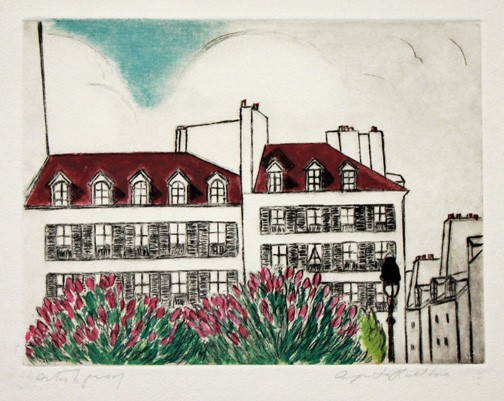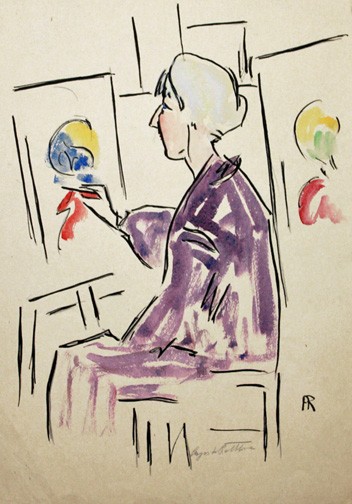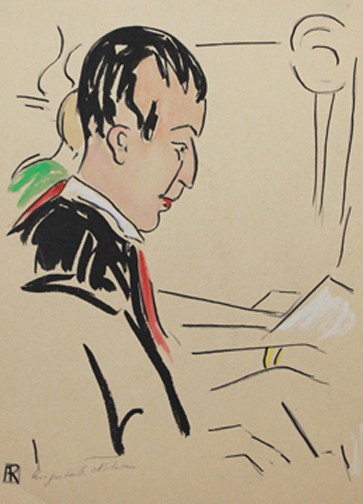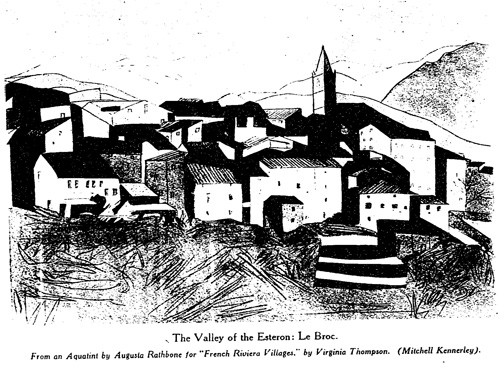Augusta Rathbone, 1897 – 1990
Augusta Payne Briggs Rathbone was born on November 13, 1897 in Berkeley, California. The daughter of Harry Bowen Rathbone and Julia Payne Briggs, she was raised in San Francisco by two French aunts. Information about her early life is scant. As Charles Shepard accurately notes, she is among those artists "who had a high measure of regard in their day, but fell into the shadows of history when their candles finally flickered out" (Fort Wayne Museum of Art blog).
Rathbone moved to Paris in 1921, after graduating from the University of California at Berkeley in 1920. Her biography on the Annex Galleries website tells us that "Rathbone returned to France for extended periods of time over the next eighteen years and her studio was located at the University Women’s Club now known as Reid Hall." She attended teas and dinners at Reid Hall from 1931– 1934 and lived at the Club in 1935.
Initially, Rathbone studied at the Académie de la Grande Chaumière, and also worked with Claudio Castelucho, Lucien Simon, and, briefly, with Pierre Bonnard. Encouraged by fellow artist Nora Hamilton, Rathbone switched to etching and learned printmaking. She became known for her aquatints and etchings, which she had printed by Alfred Porcabeuf. In Paris, she exhibited at the Salon des Beaux Arts in 1930 and 1931, and at the Salon d'Automne in 1937. Her work was also included in the exhibition American Color Prints at the Brooklyn Museum in 1933 (Annex Galleries). In 1936, Rathbone exhibited etchings of Monte Carlo, Menton, Paris, Brittany, San Francisco, and the High Sierras at the Stendahl Galleries in San Francisco. The reviewer described Rathbone's method as one that placed: "[...] her subject in sparse, bold, free deep-etched lines and lay over it strong aquatints, giving the essence of a scene simply, effectively and pleasingly in a modern impersonal style" (Los Angeles Times, January 19, 1936).
Her aquatints illustrated a limited edition of French Riviera Villages, which she produced with photographer Juliet Thompson and writer Virginia Thompson in 1938. With a limited print run of 1,000 copies, it featured 12 of her 20 aquatints of Riviera villages reproduced as photographs and hand-painted with a stencil. Shortly after its publication by Mitchell Kennerly in New York, Rathbone returned to San Francisco to pursue her artistic career.
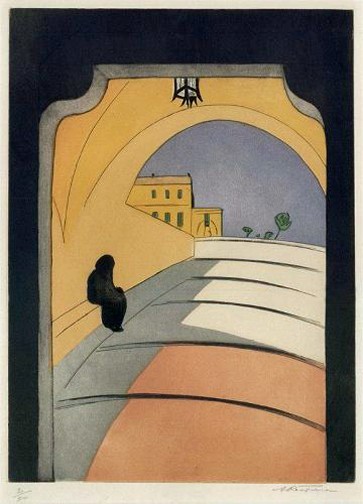
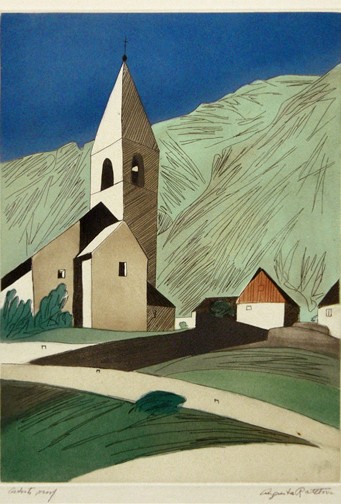
It is difficult to trace Rathbone's activities upon her return to California although some details can be gleaned from newspaper articles. Much of what we know about Rathbone is due to the efforts of Daniel Lienau, a print dealer in Santa Rosa, California and the founder of the Annex Galleries. He began exhibiting "forgotten" local printmakers and compiling their biographies in the 1970s. As his project evolved, with the help of etcher Elizabeth Ginno, he met Rathbone in the fall of 1982 in her two-room apartment in San Francisco. It contained a closet full of her prints because she "[...] had sold very little of her work over the years" (Snow 323).
Rathbone traveled extensively in Europe, Canada, and the United States, always producing etchings that she printed herself. She also became a member of the California Society of Etchers (CSE) and exhibited at their annual shows in the 1930s, 1940s, and 1950s (Snow 7921-7989). She was elected an officer of this society in 1956 and 1959 (Snow 9161-9179).
A solo show of her work was organized at the San Francisco Museum of Art in 1940. She also exhibited several French etchings she had made before WWII at the Raymond and Raymond Gallery in San Francisco in 1948 (Christian Science Monitor, May 29, 1948).
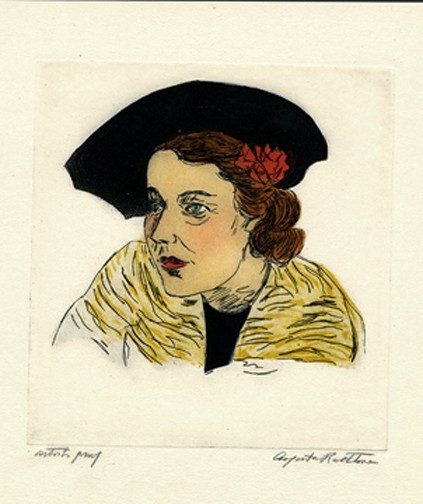
In 1941, one of San Francisco’s leading department stores, named, oddly enough, the City of Paris Dry Goods Company, promoted an “Artists’ Workshop” where customers could watch artists create handmade objects. Rathbone made sketches of customers, which she then turned into color etchings for this workshop (Annex Galleries).
Rathbone and Elizabeth Ginno exhibited 69 prints in 1954 at the San Francisco Public Library in the Civic Center (Snow 2363, 3577). The de Young Museum also showed their work in 1954, including Rathbone's "impressions of the French riviera" (San Francisco Examiner, November 14, 1954, 177). Alfred Frankenstein, art critic for the San Francisco Chronicle, reviewed the de Young show:
The exhibition of color aquatints by Augusta Rathbone, also at the de Young, is one of the most delightful print shows of the year. This artist really knows how to use color in graphic media. She employs it for modeling more than for local description, and this frees her line to crackle, dance, caricature or describe arabesques as the pictorial situation demands. The pictorial situation ranges from San Francisco through the Sierra to New York, Paris and old towns on the French Riviera, all set forth with the utmost deftness, point, character and integrity (Annex Galleries).
In 1958, Rathbone again participated in the California Society of Etchers’ exhibition.
According to Lienau, "In 1990, Augusta's work was included by Worcester Art Museum curator David Acton in his groundbreaking exhibition and book, A Spectrum of Innovation : Color in American Printmaking, 1890 – 1960. Rathbone was thrilled to finally have been acknowledged" (Snow 323). In 1990, she was featured at the California Society of Printmakers (CSP) 78th Annual Membership Exhibition at the SOMArts Cultural Center, San Francisco (Snow 8426).
Augusta Rathbone died in Palo Alto, California on March 19, 1990.
Her work can be found in the collections of the de Young Museum, Brooklyn Museum, Whitney Museum of American Art, the National Gallery of Art, and others.
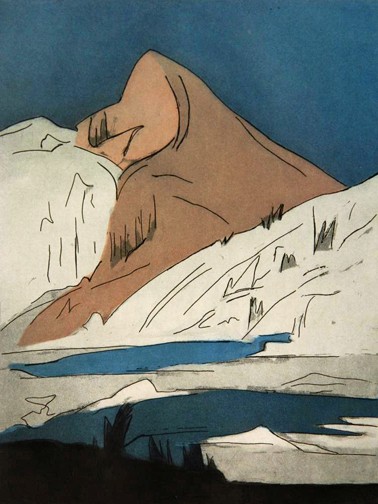
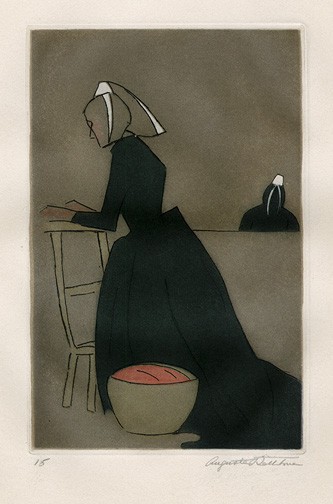
Sources
- "Art." The San Francisco Examiner, November 14, 1954, p. 177. ProQuest Historical Newspapers.
- "Art Exhibitions in San Francisco: Bay Area Painters Paris-Schooled Art," Special to The Christian Science Monitor, May 29, 1948, p. 10. ProQuest Historical Newspapers.
- "Art Exhibits in Review." Los Angeles Times, Jan 19, 1936, p. C9. ProQuest Historical Newspapers.
- "Augusta Payne Rathbone, 1897-1990." The Annex Galleries, Santa Rosa, California.
- Shepard, Charles. "Off the Cuff: Why Some and not Others." Articulate blog, Fort Wayne Museum of Art. June 19, 2018.
- Snow, Maryly, Sylvia Solochek Walters, Karin Breuer, Daniel Lienau, Art Hazelwood, Sherry Smith Bell, David R. Jones. California Society of Printmakers: One Hundred Years 1913-2013. California Society of Printmaker, 2018.
- Thompson, Virginia. French Riviera villages / aquatints by Augusta Rathbone, photographs by Juliet Thompson, text by Virginia Thompson. New York: M. Kennerley, 1938.
- University of California Register, 1919-1920. Google Books.
